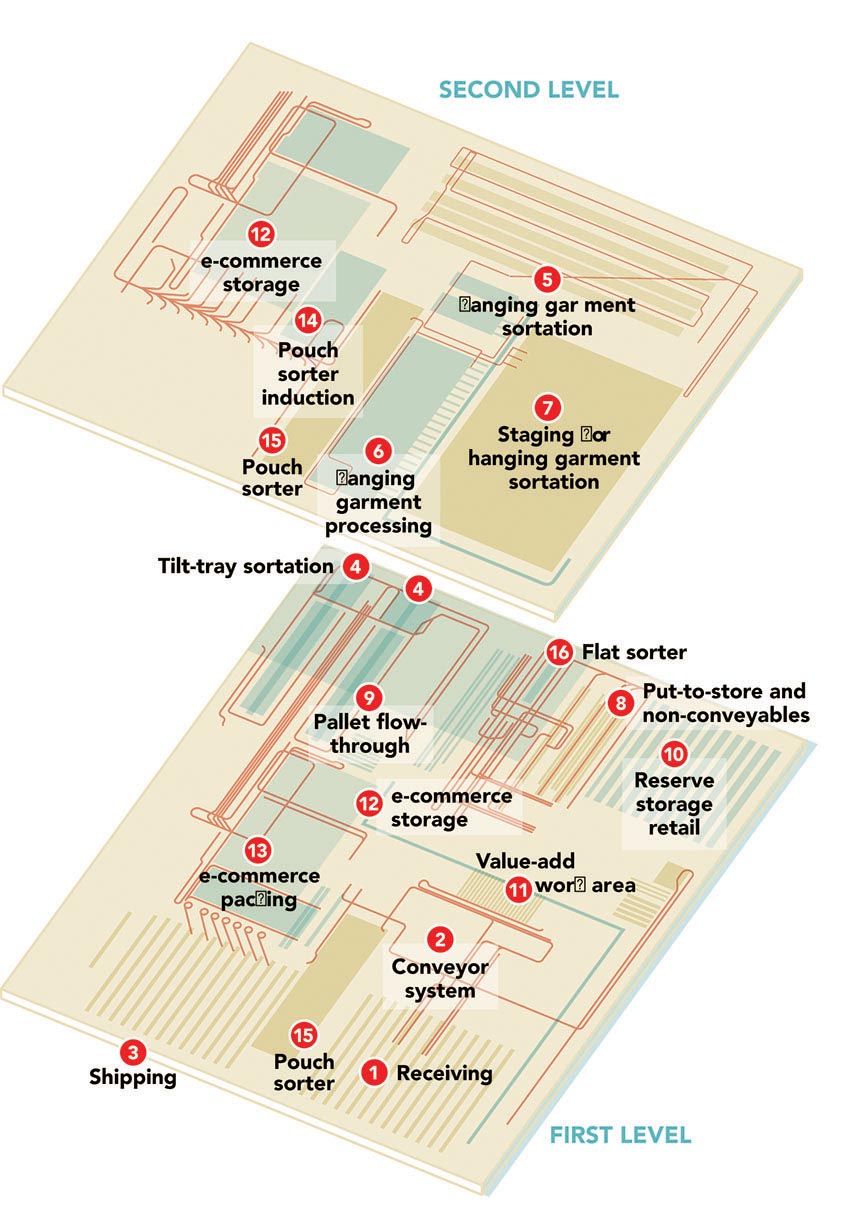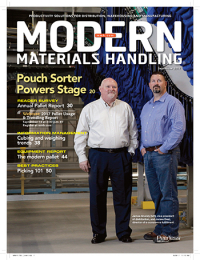Stage Stores: Meeting the e-fulfillment challenge
As Web sales continue to grow, department store operator Stage turned to pouch sortation technology to optimize its picking processes.
Stage Department Stores
Location: Jacksonville, Texas
Size: 437,000 square feet, with a 48,000-square-foot, e-commerce mezzanine. The retailer also operates three nearby annex facilities totaling 170,000 square feet.
Brands: The facility services five of Stage’s six retail brands.
Products: Everything from jewelry to shoes to home goods.
Throughput: Receives 5.1 million cartons and ships out 2.5 million cartons per year.
SKUs: 133,000 SKUs at peak for e-commerce.
Shifts per day/Days per week: Two shifts per day/five days per week; one shift for replenishment.
Employees: 450 to 550.
Until recently, crossdocking and flow-through store fulfillment were at the heart of Stage’s 437,000-square-foot distribution center in east Texas. Following the 2015 holiday season, the department store operator turned to pouch sortation to expand its e-commerce fulfillment capabilities.
Receiving
Advanced ship notices (ASNs) representing about 97% of inbound shipments are sent electronically to Stage’s transportation management system (TMS). That allows the facility to prepare for most receipts. Product is unloaded in receiving (1), where bar codes are automatically printed and applied as needed, and scanned into the warehouse management system (WMS). About 70% of inbound receipts are already allocated to stores and can be crossdocked using the conveyor system (2) to shipping (3). The remaining inventory is sent to one of three processing areas: A tilt-tray sortation area (4) is designated for items that can go into mixed cartons; a hanging garment sortation area (5) on the second level is designated for items that are handled on hangers; cartons are opened in a hanging garment processing area (6) and sent to a staging area (7) for the hanging garment sorter (5). Items that are fragile or too large for the conveyor and sortation system are sent to a manual put-to-store area (8) for processing. Other product may be processed in a floor-level, pallet flow through area (9) or in a value-added work area (11).
(Description continued below layout map.)

Storage
Inventory that isn’t crossdocked or flow-through to stores will be put away into retail reserve storage (10). Some of that inventory will be sent to one of the three nearby annex facilities that provide an additional 170,000 square feet of storage. If there is enough of an item to build a pallet of uniform product, it is palletized and labeled with a license plate bar code. Smaller quantities are placed into a carton, which is put away onto a partial pallet or on shelf storage. The inventory is now available for order fulfillment.
Picking
There are two distinct picking processes in the facility.
Store replenishment: Once a week, the WMS creates an automatic replenishment order for each of the stores. Before orders are picked, merchandisers have an opportunity to review the order and add items they would like to add to the store order. Replenishment orders are batched. Order selectors are directed to a storage location (10), where they pick a full carton or pick the number of items required for a batch of orders. Full cartons are inducted onto the conveyor system (2) and are sent to shipping (3), like a crossdocked carton. Individual items are inducted onto one of the tilt-tray sorters (4) or flat sorter (16) and consolidated by store. When a mixed carton is complete, it is put onto a conveyor (2) and sorted into an outbound truck in shipping (3).
E-commerce fulfillment: E-commerce orders are picked five days a week during non-peak times. First thing in the morning, the system creates a wave of all orders received since the last wave was run the day before. The picking process begins when order selectors log onto their RF scanning devices. They begin by picking the next available pick in their zone in the e-commerce storage area (12) and placing that item into a tub that then goes into a basket. Once all the items are picked, single line orders are sent directly to a packing station (13), where they are packed, placed on a conveyor (2) and sent to shipping (3). Multi-line orders are brought to the induction station (14) for the pouch sorter (15). Items are scanned and then placed into the next available pouch. The system joins two pieces of information—the product information and the license plate bar code—on the pouch. Once a pouch leaves the induction area (14) and travels into a primary buffer holding area, it waits until all of the items for that order are ready. Once all of the items for the order have been picked, they move into an intermediate buffer. From there, the system marries up the individual items for an order and sends them to an available pack station (13). In all, there are 10 induction stations and 24 pack stations.
Pouch sorter packing:
At the pack station, a display tells the operator that the next order should have a specific number of pieces—the average order is four pieces. The packer removes the items from the pouches and adds a packing slip that was automatically printed to the box or bag for shipping. The packed order is then conveyed (2) to the shipping area (3).
Shipping
Once a package arrives in shipping (3), an associate scans a bar code label on the packing slip. That information is used to create a shipping label that is applied to the bag or carton. The shipping container is then sealed and sorted to the right shipper.
System Suppliers
System Design, Implementation and Pouch Sortation Integration, WCS, Tilt-tray, Bomb Bay & Hanging Garment Sortation: SDI Systems
Pouch Sortation: WRH Global Americas
WMS: Oracle
Conveyor and Case Sortation:Intelligrated
Lift Trucks: Raymond and Toyota
Wrist-Mounted Mobile Comuting & Ring Scanners: Zebra Technologies (Motorola)
Mezzanine: Conveyor Solutions
Read the full system report from Modern Materials Handling here.

Article Topics
Equipment Report News & Resources
Radial stays ahead of the automation curve Wireless Mobility: Ready for the next leg up AGVs set new standards for inventory transportation Inside North Shore Care Supply: Bringing robots to receiving Bergen Logistics: Putting robots to work in a multi-tenant facility High-tech meets low-tech: Automate storage for pallet loads Tuggers, carts work together to increase productivity and ergonomics More Equipment ReportLatest in Materials Handling
Registration open for Pack Expo International 2024 Walmart chooses Swisslog AS/RS and software for third milk processing facility NetLogistik partners with Vuzix subsidiary Moviynt to offer mobility solutions for warehouses Materials Handling Robotics: The new world of heterogeneous robotic integration BSLBATT is looking for new distributors and resellers worldwide Lucas Watson appointed CSO for Körber’s Parcel Logistics business in North America Hyster recognizes Dealers of Distinction for 2023 More Materials HandlingAbout the Author
Subscribe to Materials Handling Magazine

Find out what the world's most innovative companies are doing to improve productivity in their plants and distribution centers.
Start your FREE subscription today.
April 2024 Modern Materials Handling

Latest Resources












